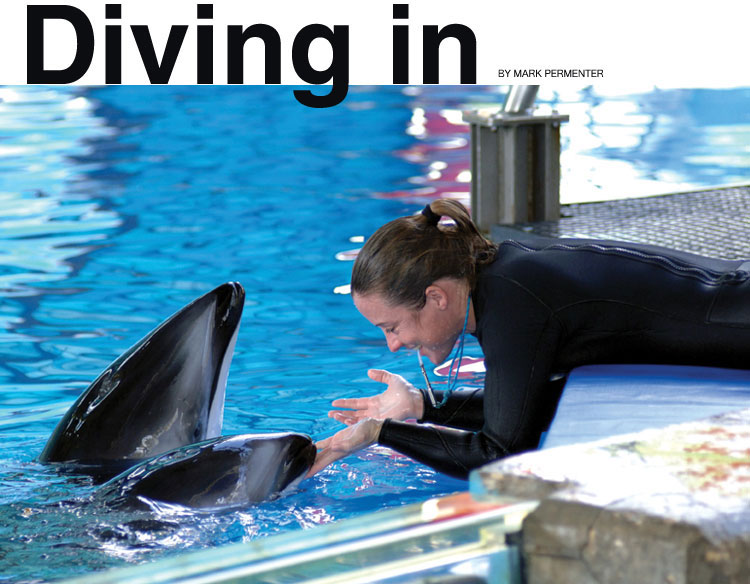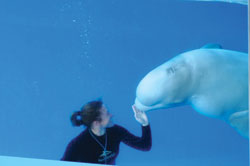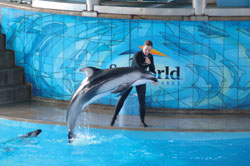FEATURE
STORIES
Diving in
Alumna Robyn Cox is on a first-name basis with dolphins and whales at SeaWorld San Antonio. As a performer in the park’s animal shows, she’s part trainer, actress and stuntwoman.

Robyn Cox bonds with Avalon and Betty, two of seven Pacific white-sided dolphins that perform in SeaWorld San Antonio's Viva! show.
Robyn Cox began her SeaWorld career selling fish for visitors to feed the dolphins. Now she feeds them herself-often after they jump 20 feet over her head, dance in circles or jet through the water as she grips their dorsal fins.
The 1996 UT Arlington psychology graduate is a senior animal trainer at the San Antonio adventure park. As a star of the Viva! show, she similarly rewards beluga whales for propelling her under water as she balances on them before they flip her 10 feet above the pool at Beluga Stadium.
Despite the constant smile, there's a tinge of trepidation each time she performs.
"You must keep in mind that you're working with animals," she said. "You can't be 100 percent sure that they're going to do what you ask them to do."
Swimming with the dolphins
After failing to land an animal training job on her first try, Cox took the fish-peddling gig and later worked in the park's aviculture department. Two years later, she scored the career she'd dreamed about as a teenager.
"It's extremely tough competition," she said of the animal training field. "There are not a whole lot of openings, and a lot of people who want them."
SeaWorld animal trainers must be scuba certified and pass a rigorous test that includes freestyle and underwater swimming, diving and treading water using only their legs. A microphone audition requires them to read part of a show script.

- Robyn Cox
Pass the test and they get an interview. Then they must convince park officials that they're interested in more than just playing with dolphins. Experience with animals is helpful but not a prerequisite. Once hired, they're assigned to a show.
Viva! features trainers, divers, aerialists and synchronized swimmers performing with Pacific white-sided dolphins and beluga whales against a backdrop of water screens, waterfalls and fountains. It's high-flying, high speed and high energy-with a high degree of difficulty that requires impeccable timing.
For the 5-foot-4 Cox, the hardest stunt to master was the dorsal tow, where two dolphins make like ski boats as she rides between them.
"They're very fast and very powerful, and their dorsal fins are slippery," she said with a laugh. "Once you figure out the correct body position, it's not that difficult."
She also has played the female lead in the Cannery Row Caper, where two sea lions try to unravel the mystery of a disappearing walrus. Though not as physically demanding in the water as Viva!, the caper show can challenge a trainer's ad-lib skills.
"Sometimes you'll have a sea lion next to you, and he'll decide to slide off into the water," Cox said. "That leaves you on stage by yourself with a microphone and 3,000 people in the audience."
Conditioned to succeed
According to the SeaWorld Web site, only in the last 30 years have trainers begun to explore the learning aptitude of marine mammals. When the animals perform a desired behavior, trainers reward them. It's called operant conditioning and has guided animal training for centuries.
In the late 1970s, SeaWorld developed a more sophisticated form of operant conditioning for marine mammals.
"Our behavior modification utilizes a variable schedule coupled with a variety of reinforcers to condition and maintain behavior," said Dave Force, vice president of zoological operations at SeaWorld San Antonio. "This combination is recognized as one of the most powerful reinforcement schedules and is used by most oceanariums today."
Food is the primary reinforcer, but others include rubdowns, ice, water toys and squirts with a water hose. Individual animals may not respond the same to the same reinforcement, so the trainer must figure out what works best with each one.
"Part of our job is to develop a relationship with an animal and know what is reinforcing and what is not," Cox said. "Belugas, by nature, are more timid. Unexpectedly jumping into a pool would be more reinforcing to a dolphin than a beluga."
With whales and dolphins, trainers blow a whistle to tell the animals they've performed as desired and may return to be reinforced. Called a bridge signal, it fills the time gap between correct behavior and reward.

Robyn Cox and dolphin Catalina practice jumping drills.
Trainers conduct at least three sessions per day, each 2-20 minutes. Some are learning sessions, but others are play times, relationship builders and feeding periods. The laid-back belugas respond better to longer sessions than the active Pacific white-sided dolphins. Schedules vary to keep the animals interested.
It takes about a year for the animals to become performers. They're set up to succeed, beginning with small parts before advancing to more complicated behaviors. Just like humans, they have bad days.
"They definitely have their off shows, but so do we," said Cox, who has worked at SeaWorld San Antonio since 1997. "Some people are really good at math, and some are really good at reading. Some of the animals are really good at some things, and some are really good at other things."
Patience can be a trainer's best friend.
"We don't make them do anything. We ask them to do things, and luckily, most of the time they do them. But there are times when we don't get what we ask for."
Dream job
Growing up in Arlington, Cox had an assortment of dogs, birds, fish, hamsters, gerbils and a cat named Kitty that lived to be 22. She and her husband, Brian, who works in SeaWorld's animal care department, have three dogs at their San Antonio home.
She decided she wanted to be a dolphin trainer in junior high.
"Knowing her love for animals, Robyn just thought that would be a fun job," said Sherry Gould, her mother. "She just never wavered from that idea. After her first trip to SeaWorld in ninth grade, the thought was cemented in her mind."
Thinking she needed a marine biology degree, Cox spent two years at Texas A&M-Galveston. When she discovered that psychology was actually the preferred field for animal trainers, she enrolled at UT Arlington.
Just like her older brother, Clay Gould. A baseball star who later became UT Arlington's head coach, Gould died of cancer in 2001 at age 29. The University's baseball stadium bears his name.
Pictures of Clay and his daughter, Logan, hang in Robyn's locker at SeaWorld. His memory is never far away.
"Clay did so many amazing things in such a short period of time," Cox said. "I could look up to him and know that was what success looked like personally and professionally."
For the 33-year-old marine mammal trainer, success often takes the form of breathtaking water acrobatics. Dives, flips, somersaults, twists, rides and games with animals that she's taught-it's her dream career.
"Doesn't every teenager want to be a dolphin trainer at some point?" she asks.
Maybe, but most never get there.
| Beluga Whale |
vs. | Pacific White-sided Dolphin |
|---|---|---|
| Sources: MarineBio.org, Whale-Images.com, SeaWorld.org | ||
| up to 18 feet | LENGTH | up to 8 feet |
| up to 3,000 pounds | WEIGHT | up to 330 pounds |
| up to 35 years | LIFESPAN | up to 40 years |
| fish, octopus, squid, crabs, snails | EATS | small fish, squid |
| in groups of 2-15, tight mother/calf association | TRAVELS | in schools of 90-100 called pods |
| 13 mph | TOP SPEED | 25 mph |
| friendly, smart, shy | PERSONALITY | intelligent, energetic, short attention span |
| with a vast repertoire of whistles, belches and squeaks | COMMUNICATES | with high-pitched squeals, whistles, and whines |
| nine pair in the upper jaw, eight pair in the lower jaw | TEETH | 23-32 small, rounded, slightly curved teeth in each side of the upper and lower jaws |
| killer whales, polar bears, humans | PREDATORS | killer whales, sharks, humans |
| 50,000-70,000 | POPULATION | unknown |
— Mark Permenter
